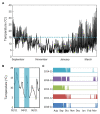Feeling Every Bit of Winter - Distributed Temperature Sensitivity in Vernalization
- PMID: 33584778
- PMCID: PMC7873433
- DOI: 10.3389/fpls.2021.628726
Feeling Every Bit of Winter - Distributed Temperature Sensitivity in Vernalization
Abstract
Temperature intrinsically influences all aspects of biochemical and biophysical processes. Organisms have therefore evolved strategies to buffer themselves against thermal perturbations. Many organisms also use temperature signals as cues to align behavior and development with certain seasons. These developmentally important thermosensory mechanisms have generally been studied in constant temperature conditions. However, environmental temperature is an inherently noisy signal, and it has been unclear how organisms reliably extract specific temperature cues from fluctuating temperature profiles. In this context, we discuss plant thermosensory responses, focusing on temperature sensing throughout vernalization in Arabidopsis. We highlight many different timescales of sensing, which has led to the proposal of a distributed thermosensing paradigm. Within this paradigm, we suggest a classification system for thermosensors. Finally, we focus on the longest timescale, which is most important for sensing winter, and examine the different mechanisms in which memory of cold exposure can be achieved.
Keywords: Arabidopsis; FLC; climate change; mathematical modeling; temperature fluctuations; temperature-sensing; vernalization.
Copyright © 2021 Antoniou-Kourounioti, Zhao, Dean and Howard.
Conflict of interest statement
The authors declare that the research was conducted in the absence of any commercial or financial relationships that could be construed as a potential conflict of interest.
Figures


Similar articles
-
Temperature Sensing Is Distributed throughout the Regulatory Network that Controls FLC Epigenetic Silencing in Vernalization.Cell Syst. 2018 Dec 26;7(6):643-655.e9. doi: 10.1016/j.cels.2018.10.011. Epub 2018 Nov 28. Cell Syst. 2018. PMID: 30503646 Free PMC article.
-
Temperature-dependent growth contributes to long-term cold sensing.Nature. 2020 Jul;583(7818):825-829. doi: 10.1038/s41586-020-2485-4. Epub 2020 Jul 15. Nature. 2020. PMID: 32669706 Free PMC article.
-
Natural temperature fluctuations promote COOLAIR regulation of FLC.Genes Dev. 2021 Jun;35(11-12):888-898. doi: 10.1101/gad.348362.121. Epub 2021 May 13. Genes Dev. 2021. PMID: 33985972 Free PMC article.
-
Is winter coming? Impact of the changing climate on plant responses to cold temperature.Plant Cell Environ. 2023 Nov;46(11):3175-3193. doi: 10.1111/pce.14669. Epub 2023 Jul 12. Plant Cell Environ. 2023. PMID: 37438895 Review.
-
Vernalization and epigenetics: how plants remember winter.Curr Opin Plant Biol. 2004 Feb;7(1):4-10. doi: 10.1016/j.pbi.2003.11.010. Curr Opin Plant Biol. 2004. PMID: 14732435 Review.
Cited by
-
A regulatory module mediating temperature control of cell-cell communication facilitates tree bud dormancy release.EMBO J. 2024 Dec;43(23):5793-5812. doi: 10.1038/s44318-024-00256-5. Epub 2024 Oct 3. EMBO J. 2024. PMID: 39363036 Free PMC article.
-
Deprivation of Sexual Reproduction during Garlic Domestication and Crop Evolution.Int J Mol Sci. 2023 Nov 26;24(23):16777. doi: 10.3390/ijms242316777. Int J Mol Sci. 2023. PMID: 38069099 Free PMC article.
-
Flower Development in Arabidopsis.Methods Mol Biol. 2023;2686:3-38. doi: 10.1007/978-1-0716-3299-4_1. Methods Mol Biol. 2023. PMID: 37540352
-
Epigenetic stress memory: A new approach to study cold and heat stress responses in plants.Front Plant Sci. 2022 Dec 8;13:1075279. doi: 10.3389/fpls.2022.1075279. eCollection 2022. Front Plant Sci. 2022. PMID: 36570899 Free PMC article. Review.
-
Getting it right: suppression and leveraging of noise in robust decision-making.Quant Plant Biol. 2024 Nov 27;5:e10. doi: 10.1017/qpb.2024.10. eCollection 2024. Quant Plant Biol. 2024. PMID: 39777031 Free PMC article. Review.
References
-
- Antoniou-Kourounioti R. L., Hepworth J., Heckmann A., Duncan S., Questa J., Rosa S., et al. . (2018). Temperature sensing is distributed throughout the regulatory network that controls FLC epigenetic silencing in vernalization. Cell Syst. 7, 643–655.e9. 10.1016/j.cels.2018.10.011, PMID: - DOI - PMC - PubMed
Publication types
Grants and funding
LinkOut - more resources
Full Text Sources
Other Literature Sources

